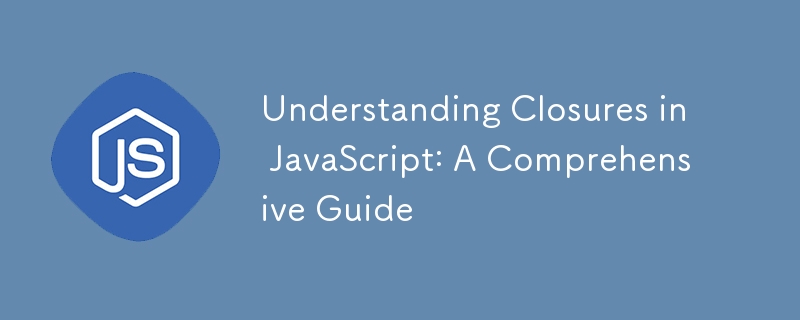Home >Web Front-end >JS Tutorial >Understanding Closures in JavaScript: A Comprehensive Guide
Understanding Closures in JavaScript: A Comprehensive Guide
- PHPzOriginal
- 2024-07-26 17:06:24532browse

JavaScript is a versatile and powerful language, and one of its most intriguing features is the concept of closures. Closures are fundamental to understanding how JavaScript functions work, especially in relation to scope and variable access. In this tutorial, we'll explore what closures are, how they work, and provide practical examples to help you master this concept.
What is a Closure?
A closure is a function that retains access to its lexical scope, even when the function is executed outside that scope. In simpler terms, a closure allows a function to "remember" the environment in which it was created.
Why are Closures Important?
Closures are essential for several reasons:
Data Privacy: Closures enable you to create private variables that cannot be accessed from outside the function.
Stateful Functions: They allow functions to maintain state between calls.
Functional Programming: Closures are a key concept in functional programming, enabling higher-order functions and currying.
How Do Closures Work?
To understand closures, let's start with a basic example:
function outerFunction() {
let outerVariable = 'I am outside!';
function innerFunction() {
console.log(outerVariable);
}
return innerFunction;
}
const myClosure = outerFunction();
myClosure(); // Output: I am outside!
In the above example:
outerFunctioncreates a variable outerVariable and defines innerFunction.
innerFunctionaccesses outerVariable, which is in its lexical scope.
outerFunctionreturns innerFunction, creating a closure.
When myClosureis called, it still has access to outerVariableeven though outerFunctionhas finished executing.
Practical Examples of Closures
1. Creating Private Variables
Closures can be used to create private variables that can only be accessed or modified through specific functions.
function createCounter() {
let count = 0;
return {
increment: function() {
count++;
return count;
},
decrement: function() {
count--;
return count;
},
getCount: function() {
return count;
}
};
}
const counter = createCounter();
console.log(counter.increment()); // 1
console.log(counter.increment()); // 2
console.log(counter.decrement()); // 1
console.log(counter.getCount()); // 1
In this example, countis a private variable that can only be accessed and modified through the methods increment, decrement, and getCount.
2. Creating Functions Dynamically
Closures allow you to create functions dynamically with specific data.
function greetingGenerator(greeting) {
return function(name) {
return `${greeting}, ${name}!`;
};
}
const sayHello = greetingGenerator('Hello');
const sayGoodbye = greetingGenerator('Goodbye');
console.log(sayHello('Alice')); // Hello, Alice!
console.log(sayGoodbye('Bob')); // Goodbye, Bob!
Here, greetingGenerator creates a closure with the greeting variable, allowing sayHello and sayGoodbye to use it when called.
3. Maintaining State in Asynchronous Code
Closures are particularly useful in asynchronous programming, where you need to maintain state across different parts of your code.
function fetchData(url) {
let cache = {};
return function() {
if (cache[url]) {
return Promise.resolve(cache[url]);
} else {
return fetch(url)
.then(response => response.json())
.then(data => {
cache[url] = data;
return data;
});
}
};
}
const getUserData = fetchData('https://jsonplaceholder.typicode.com/users/1');
getUserData().then(data => console.log(data)); // Fetches data from the API
getUserData().then(data => console.log(data)); // Returns cached data
In this example, cacheis maintained across multiple calls to getUserData, ensuring that datais fetched only once per URL and reused subsequently.
Conclusion
Closures are a powerful feature of JavaScript that allow functions to retain access to their lexical scope, even when executed outside that scope. They enable data privacy, stateful functions, and are a cornerstone of functional programming. By understanding and using closures, you can write more efficient, readable, and maintainable JavaScript code.
Experiment with closures in your projects, and you'll soon appreciate their versatility and power. Happy coding!
The above is the detailed content of Understanding Closures in JavaScript: A Comprehensive Guide. For more information, please follow other related articles on the PHP Chinese website!
Related articles
See more- An in-depth analysis of the Bootstrap list group component
- Detailed explanation of JavaScript function currying
- Complete example of JS password generation and strength detection (with demo source code download)
- Angularjs integrates WeChat UI (weui)
- How to quickly switch between Traditional Chinese and Simplified Chinese with JavaScript and the trick for websites to support switching between Simplified and Traditional Chinese_javascript skills

